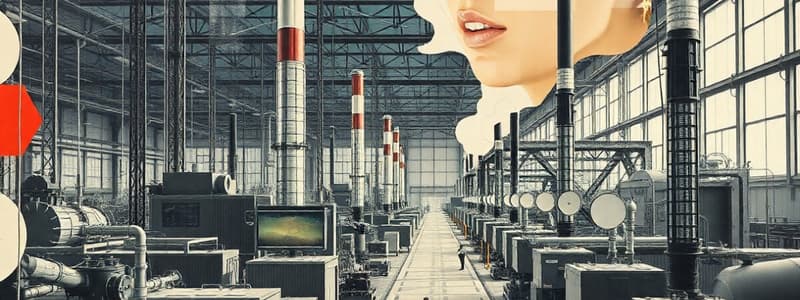Podcast
Questions and Answers
Which of the following is NOT a key principle of smart factories?
Which of the following is NOT a key principle of smart factories?
- Data-driven decision making
- Advanced automation
- Interconnectivity
- Centralized control (correct)
How do smart factories contribute to sustainability?
How do smart factories contribute to sustainability?
- By increasing production output regardless of resource consumption
- By optimizing resource utilization and reducing waste (correct)
- By solely relying on fossil fuels for energy
- By ignoring environmental regulations
Which of the following real-world examples uses AI-enabled cutting machines and networked sewing equipment to create an agile production system?
Which of the following real-world examples uses AI-enabled cutting machines and networked sewing equipment to create an agile production system?
- Alibaba (correct)
- Dubai Electricity and Water Authority (DEWA)
- Tesla Gigafactory
- Saudi Aramco
What is the primary function of Cyber-Physical Systems (CPS) in Industry 4.0?
What is the primary function of Cyber-Physical Systems (CPS) in Industry 4.0?
Which of the following is NOT a component of Cyber-Physical Systems (CPS)?
Which of the following is NOT a component of Cyber-Physical Systems (CPS)?
What is the role of sensors within the physical components of CPS?
What is the role of sensors within the physical components of CPS?
How do smart cities primarily optimize city functions, services and infrastructure?
How do smart cities primarily optimize city functions, services and infrastructure?
Which of the following BEST describes the role of citizen participation in the smart city concept?
Which of the following BEST describes the role of citizen participation in the smart city concept?
What is the main purpose of the 'Dubai 10X' vision?
What is the main purpose of the 'Dubai 10X' vision?
What role do smart meters play in the Dubai Electricity and Water Authority (DEWA) initiative?
What role do smart meters play in the Dubai Electricity and Water Authority (DEWA) initiative?
In the context of smart factories, how does real-time data analysis contribute to flexibility and agility?
In the context of smart factories, how does real-time data analysis contribute to flexibility and agility?
What is the most important role of data-driven insights in smart factories?
What is the most important role of data-driven insights in smart factories?
Why is network connectivity so critical for CPS?
Why is network connectivity so critical for CPS?
What is a key benefit of real-time monitoring via CPS?
What is a key benefit of real-time monitoring via CPS?
Which of the following BEST describes sustainable practices in smart cities?
Which of the following BEST describes sustainable practices in smart cities?
Flashcards
Smart Factory Definition
Smart Factory Definition
A highly integrated and interconnected production environment leveraging advanced technologies to create an intelligent and autonomous manufacturing system.
Interconnectivity
Interconnectivity
Machines, devices, and sensors are seamlessly connected, enabling real-time data exchange and collaboration.
Data-Driven Decision Making
Data-Driven Decision Making
Smart factories collect and analyze vast amounts of data to identify trends, optimize operations, and predict maintenance needs.
Cyber-Physical Integration
Cyber-Physical Integration
Signup and view all the flashcards
Advanced Automation
Advanced Automation
Signup and view all the flashcards
Flexibility and Agility
Flexibility and Agility
Signup and view all the flashcards
Sustainability in Factories
Sustainability in Factories
Signup and view all the flashcards
Increased Productivity/Efficiency
Increased Productivity/Efficiency
Signup and view all the flashcards
Improved Quality Control
Improved Quality Control
Signup and view all the flashcards
Enhanced Factory Safety
Enhanced Factory Safety
Signup and view all the flashcards
Reduced Factory Costs
Reduced Factory Costs
Signup and view all the flashcards
Greater Factory Innovation
Greater Factory Innovation
Signup and view all the flashcards
Cyber-Physical Systems (CPS)
Cyber-Physical Systems (CPS)
Signup and view all the flashcards
CPS Sensors
CPS Sensors
Signup and view all the flashcards
CPS Actuators
CPS Actuators
Signup and view all the flashcards
Study Notes
Smart Factories: The Powerhouse of Industry 4.0
- A Smart Factory is a highly integrated and interconnected production environment.
- Smart Factories leverage Cyber-Physical Systems (CPS), Artificial Intelligence (AI), and the Internet of Things (IoT).
- Smart Factories create an intelligent and autonomous manufacturing system.
Key Principles of Smart Factories
- Interconnectivity: Machines, devices, and sensors are seamlessly connected through wired or wireless networks for real-time data exchange.
- Data-Driven Decision Making: Smart factories collect and analyze vast amounts of data using advanced analytics tools to identify trends and predict maintenance needs.
- Cyber-Physical Integration: Physical machinery is integrated with computational capabilities, machines now monitor performance and make autonomous decisions based on real-time data.
- Advanced Automation: Robots and other automation technologies handle repetitive tasks, perform complex operations, and collaborate with human workers.
- Flexibility and Agility: Smart factories adapt to changing production demands and market conditions through real-time data analysis.
- Sustainability: Smart factories optimize resource utilization, reduce waste, and integrate renewable energy sources.
Benefits of Smart Factories
- Increased Productivity and Efficiency: Optimized processes and real-time decision-making lead to significant gains.
- Improved Quality Control: Real-time monitoring and data analysis allow for early detection of defects.
- Enhanced Safety: Advanced automation and human-machine collaboration improves safety.
- Reduced Costs: Lower energy consumption, optimized resource usage, and predictive maintenance leads to cost reductions.
- Greater Innovation: Data-driven insights and increased agility fuel innovation.
Real-World Examples of Smart Factories
- Tesla Gigafactory (Berlin, Germany) leverages AI and cloud technologies for electric vehicle production.
- Alibaba (Hangzhou, China) uses cloud-based computing and IoT to create an agile fashion-and-apparel production system.
- Saudi Aramco (Saudi Arabia) uses over 40,000 sensors in the Khurais oil field, along with big-data analytics, AI, robotics, and digital twins.
Cyber-Physical Systems (CPS): The Brains Behind Industry 4.0
- Cyber-Physical Systems (CPS) bridge the gap between the physical world of machinery and the digital realm of data and computation.
- CPS integrates physical machinery with computational capabilities, collect data, monitor performance, and communicate with systems.
- CPS even make autonomous decisions based on real-time information.
Main Components of CPS
- Physical Components: These are tangible parts, including sensors, actuators, and machines & equipment.
- Computational Components: The "brain" of the system, encompassing microcontrollers and software.
- Network Connectivity: CPS relies on communication networks (wired or wireless) to connect and share data.
The Power of CPS in Industry 4.0
- Real-time Monitoring: Continuously monitor machinery performance.
- Data-Driven Decision Making: Analyze data to optimize production and predict future needs.
- Autonomous Control: Advanced CPS make autonomous decisions based on real-time data.
- Enhanced Human-Machine Collaboration: Work alongside humans, providing data and safety.
Smart Cities: The Evolving Landscape of Industry 4.0
- Smart Cities leverage technology to create more efficient, sustainable, and citizen-centric urban environments.
- A Smart City utilizes a network of interconnected devices, sensors, and data analytics.
- A Smart City optimizes city functions, services, and infrastructure.
Main Components of Smart Cities
- Information and Communication Technology (ICT) Infrastructure: Forms the backbone, providing a network for data collection, communication, and includes internet, cloud computing, also sensor networks.
- Data Analytics: Analyzes data collected from sensors, traffic systems, and citizen to identify trends, predict problems, and make informed decisions.
- Citizen Engagement: Prioritizes citizen participation through interactive that allows citizens to participate in decision-making, and feel more connected to their city.
- Sustainable Practices: Aims to reduce environmental impact by optimizing energy use, waste management, and green transportation.
Examples of Smart City Initiatives in the UAE
- Dubai aims to be 10 years ahead of other cities in key sectors through its "Dubai 10X" vision.
- The Dubai Electricity and Water Authority (DEWA) utilizes smart meters and AI to optimize energy usage and reduce water waste.
- The Roads and Transport Authority (RTA) implements smart traffic management systems and promotes sustainable transportation options.
- Abu Dhabi focuses on areas such as Masdar City, a planned sustainable city that uses renewable energy sources.
- The Integrated Transport Centre (ITC) provides a unified platform for managing public transportation systems across the emirate.
Studying That Suits You
Use AI to generate personalized quizzes and flashcards to suit your learning preferences.




